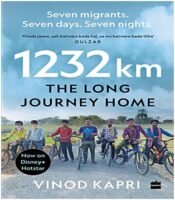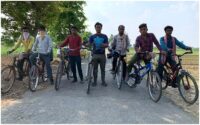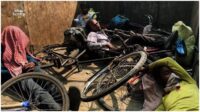Last Updated on August 17, 2021 by themigrationnews

Introduction to the journey
1232 kms is a documentary movie made in the Indian Hindi language which is directed by Vinod Kapri. The documentary was released on the 24th of March 2021 on the digital platform- Disney+ Hotstar. It was produced by Guneet Monga and Smriti Mundhra and edited by Hemanti Sarkar. Rekha Bhardwaj and Sukhwinder Singh gave their voices and lyricist Gulzar teamed up with Vishal Bhardwaj to produce soulful music for the movie. The tunes add a layer of poignancy to the movie. The movie highlights the plight of seven daily wages and contract migrant workers. During lockdown[i], their decision to return to their place of origin (hometown), which is 1232 kilometers away, and the experiences in between constitute the central theme. In 86 minutes, their journey is captured in a realistic way.
Visuals of mass migration
The movie begins with the visuals of thousands of migrants moving forward to reach their hometowns from their places of work. Some are seen moving on their feet, some with cycles along with their belongings. Surrounding the largest humanitarian crisis after Partition, this movement of the migrants can be called a crisis event. In this part of the crisis, capturing the real stories of the entire population who migrated was not possible. But Vinod Kapri has given us the most brilliant piece of reality check. Pain and struggle might bring out tears, but the migrants’ reunion with their respective families will bring smiles and tears of joy at the end.
As we watch the movie in the year 2021, we go back to the year 2020, where in March, the historic decision was taken by the Indian government to lockdown the entire nation for few days (due to COVID-19). The lockdown eventually got extended multiple times. The fate of approximately 30 million migrants suddenly became uncertain. In the next scene, Kapri then moves his camera to focus on few people (migrants) talking amongst themselves regarding getting beaten up by their contractor upon asking for some amount of money to return home. Till this scene the migrants were not introduced to us. This is where reality starts knocking when Ritesh, who is one of the seven migrants refers to the working conditions in the city and says that“there is no place for the poor in India.”
Who are these seven migrants?
Along with the director himself and his crew members, we can see seven migrants who cycled, swam across Ganga, and faced challenges on the roads amidst the lockdown to reach their hometown Saharsa, Bihar from their place of work in Delhi. Each of the seven migrants is the face and voice of the movie. Ritesh Kumar Pandit, Ashish Kumar, Ram Babu Pandit, Mukesh Kumar, Krishna, Sonu Kumar, Sandeep Kumar are the migrants we can see in their seven-day journey (see picture 2).
A hope that never exhausted
As the movie progresses, the journey seems like our own with nail-biting moments. We see the migrants narrate about their savings that got exhausted in a month and their basic needs were in jeopardy. After almost six months of their struggle to survive in the city, they decided to take a risk and return to their hometown. They had to either borrow money for transport or buy new cycles. Along with the migrants, their cycles play an important role in their journey which is evident in the entire movie. The migrants decided to paddle through village roads instead of the highways. When asked by Kapri, they recalled how they were beaten up by the police near Hapur. One of them even said that “Marjayenge woh toh theek hai, lekin police waale ke haath nahi aayenge.”Meaning: It is okay if we die but we will not let ourselves be caught by the policemen.
The journey was captured by Vinod Kapri who along with them traveled to their hometown capturing their emotions. One may ask: how was the director not caught by police when there was a strict lockdown? Did he come with permission? As an audience, I expected to know these details which were not included in the movie. But this documentary brings out reality from the lens of the migrants which might have remained as data for the rest of the world. With each passing day and covering multiple kilometres, the migrants never lost their hope to see their family members and escape the brutal crisis of their lives.
A surprising destiny on the way
The initial days of their journey were filled with problems including cycles getting punctured multiple times, denied access to shops and so on. However, as the movie progresses we can see kind people like the dhaba owner, one policeman, truck drivers who put forward their helping hands to the migrants in their way and solved their problems (see picture 3). We can see a blend of experiences where the migrants kept on moving despite several hurdles on the way and on the other hand people of villages were kind to help whenever they were stuck. At different parts of their journey, serendipity was awaiting for them. As we can see people went out of their way to help the pardesis[ii]. For the migrants, surviving through this journey was not an easy task. Even though all the migrants were not related by blood, they travelled this entire journey together like a family. All the seven migrants never left each other even when one fell ill at night, or their cycles were punctured in the middle of the road. They are seen to motivate each other throughout the journey. We can see how networks help each other in times of need. With the help of mobile navigation GPS they found out alternative ways to reach their destination without getting caught by the authorities on their way.
Shorter the distance- higher the hopes
Slowly when the distance became shorter, the migrants can be seen with less rage on their face and ray of hope to reach their respective places. While moving along in his car, Kapri shot the grim humour, fear, and love for family, kindness in the migrants when the migrants were paddling alongside and expressing all these.While watching, one may wonder why there is a Bollywood touch in this documentary (particularly the use of songs or music). But the music pulled out the emotions from the screen to the audience’s eyes.
Time and again we can see Vinod Kapri making an appearance in front of the camera which assured that he went into deep-end by indulging himself. The effort to show what a pandemic looks like for the ‘have-nots’ came out through this movie which makes us realise how massive the situation was that time. Kapri never stopped recording, and this is the beauty of the movie when we see the journey during the night-time. One can feel the emotions when Kapri zooms the camera on the teary eyes of the migrants. In another scene Kapri zooms to the bathing moment and it shows how realistically it was shot to capture the smallest details. Their bodies fatigued but their determination never dimmed for a second.
The journey allows us to understand the plight of the migrants during the pandemic lockdown. The story also shows both sides of human nature, how some people helped them and at the same time how someone denied helping them. The documentary is touching, heart wrenching and so emotional to go through the 86 minutes. We had already seen clips of teary-eyed migrants on the News channel but this documentary touches our heart in a different way. People like us who have resources and all the basic needs (haves of the society) had to go out only to buy essentials like groceries or medicines. Majority of the time we spent on watching news channels which showed the vulnerable side of the society where have-nots went through a crisis. It came to a point where they exhausted their resources and a decision had to be made. Few clips on the television did no justice as to how migrants are managing to travel the entire distance in reality. This movie thus will open our minds to think that these seven migrants are only a fraction amongst lakhs who migrated and each one of them has a story to tell of their journey during the pandemic. Halfway through this movie, we might keep on asking ourselves how are they going to complete this journey without money in their pocket? How are they getting emotional and physical strength to keep moving? All these are answered while the movie shreds its layers.
What can we conclude?
A decision on imposing a lockdown at the eleventh hour by the Government of India, takes us back to some of the wrenching scenes in this movie which shows that migrant and daily wage workers in big and small cities were not going to be able to hold without wages. They will eventually exhaust their resources by the multiple extensions of lockdowns and finally left with no resources to pay for food. It was also seen in the news that migrants were abandoned by their employers and thousands of men, women and children were distressed. Amidst the chaos and non-fulfilment of demands for transporting them safely to their hometowns, the migrants became desperate and with self-reliance they started their journey by walking, cycling or taking lift from truck drivers.
Eventually this entire mass movement had compelled the authorities to provide transport facilities to the migrants with the help of state government transport bodies. The lesson learnt was late but these migrants who took the strong decision for themselves became hero for others to stand against the authority to provide transport.
Finally, this documentary movie is highly recommended to everyone to understand the vulnerabilities faced by the migrants during reverse migration. Much before the transport facility came into force, already the mass reverse migration started. Thus, even with seven migrants, this documentary gives us a bigger picture of the mass migration that had happened in India during the pandemic lockdown in 2020. The scenes clearly show what pandemic looked like for the people who were neglected, uninformed, and left without basic resources to survive. Covering the entire 1232 kilometres with full of emotion, courage, and endless spirit to live will inspire us in some way. Therefore, to listen to original and real voices is only going to take us back and rethink the migrants’ struggle for survival and the happiness family reunion brings.The documentary thus has a perfect title which reveals migrants’ journey through 1232 kilometres and inspiring several others.
[i] Lockdown: In India, to tackle the problem of COVID-19 spread and prohibition of any kind of movement, lockdown was imposed by the Government in March 2020.
[ii] Pardesi is a local Hindi word that means foreigner.

Piyali Bhowmick is a PhD Scholar at the Tata Institute of Social Sciences, Guwahati Off Campus, India
Email: piyali.bhowmick@gmail.com


